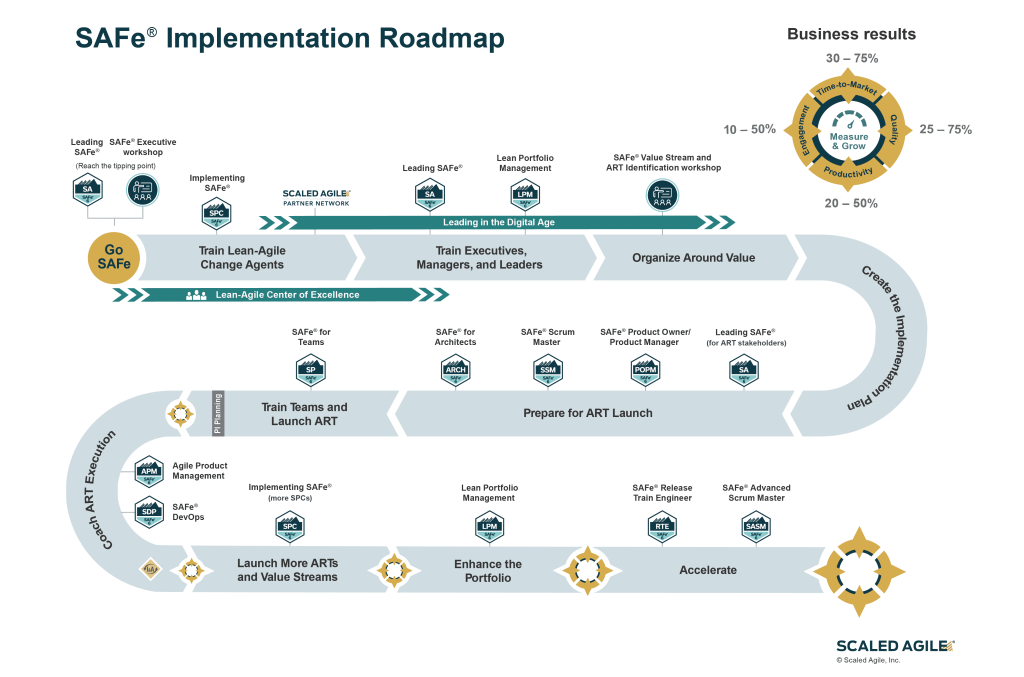SAFe Transformation Approach
Build up the vision for change
There must be a convincing explanation behind the change, and a dream to oblige it. The vision for change fills three essential needs:
It explains the reason and course for the change and sets the crucial all to follow. It keeps away from the bunch of confounding expected subtleties and spotlights everybody on the why, not the how, of the change.
It begins to move individuals the correct way. All things considered, change is hard, and torment is inescapable, particularly in the early going. Individuals’ occupations will change. The vision propels individuals by giving them a convincing motivation to roll out the improvement. Maybe in particular, it underlines that there is actually no employer stability is the norm.
It helps start the planned activity important to guarantee that hundreds, maybe even thousands, of individuals cooperate toward another—and all the more expressly fulfilling—objective. With clearness of vision, individuals are engaged to take the nitty gritty activities important to accomplish the vision, without the steady requirement for the executive’s management or check-in.
why training is important

Our way of thinking is straightforward: the duty regarding Lean-Agile appropriation and achievement lies with the undertaking’s current administrators, pioneers, and chiefs. Such a duty can’t be appointed to the Agile Center for Excellence (ACE), improvement groups, or outside experts. To accomplish Lean-Agile reception, pioneers must be prepared in these new and imaginative perspectives and working.
SAFe® Agilists display the accompanying qualities:
- They are prepared in Lean and Agile standards and base their everyday choices on this drawn out way of thinking
- They create individuals, and their kin create arrangements
- They comprehend and show Lean and Agile practices
- They are prepared in the practices and instruments of constant improvement and show representatives critical thinking and restorative activity aptitudes
- They are hands-on in the new procedure, and they assume individual liability for Lean-Agile achievement
One wellspring of such preparing is the course Leading the Lean-Agile Enterprise with the Scaled Agile Framework® (Leading SAFe®), conveyed by guaranteed experts or mentors in open enlistment or on location settings.
Each course is intended to assist people with expanding the estimation of their job inside a SAFe association, and to assist them with progressing all through their profession as they practice, counsel, or train others in SAFe. The outcome is better usage, and more noteworthy solidness for the association.
Following the Implementation Roadmap

One of the initial steps to extending SAFe is to recognize the Value Streams inside the undertaking. Endeavouring to an easy route or breeze through this progression would be equivalent to putting your foot on the brake simultaneously you are attempting to quicken. Getting esteem streams right, notwithstanding, makes an association advanced to encourage the progression of significant worth across useful storehouses, exercises, and limits
Distinguishing Value Streams is conceivably the most significant initial phase in propelling an effective Agile Release Train (ART). Worth Streams are the essential Scaled Agile Framework (SAFe) built for comprehension, sorting out, and conveying an incentive to the client and therefore to the venture itself. Understanding the real progression of significant worth in a venture is a test that must be tended to in the particular business setting, and can turn out to be increasingly more convoluted as undertakings become bigger.
When the worth streams and ARTs have been distinguished, it’s an ideal opportunity to begin placing the arrangement energetically. Recognize the groups on the underlying ART dispatch. Choose which colleagues will fill which jobs. Timetable the preparation of every one of these jobs and the PI Planning occasion. It is likewise never too soon to begin considering when extra ARTs and worth streams would turn out over the association. At this point, the new vision is regularly being imparted around the organization, head partners are adjusting, and individuals are beginning to detect that something important is noticeable all around. Making a Program Increment Roadmap assists with delineating the theory of when, where, and how the rollout may happen at a significant level.
Much in the wake of having moved beyond the tipping point of choosing to actualize the Framework, it is essential to keep an eye out for the regular difficulties and traps of full authoritative change. While each SAFe usage is one of a kind, many follow similar examples, face similar difficulties, and require similar strides to accomplish genuine undertaking dexterity. Following the Implementation Roadmap can assist associations with remaining on the correct way during their excursion.
- Failing to establish a sense of urgency:A leading person is needed to “toot the horn” and drive the change. Without a sense of why this change is important, the organization will fail to see its value.
- Not creating a guiding coalition: SAFe® Program Consultants (SPCs) and executive SAFe® Agilists (SAs) need to buy in and believe in what they are doing. If leadership has not bought in, the implementation will fail. It’s impossible to have one without the other.
- Underestimating the power of vision and strategy: Organizational change is not something that can be done without a solid plan in place. The enterprise must understand all the players and where they fit in the transformation.
- Under-communicating the vision: It’s not possible to over-communicate the vision. Alignment is key. If a single person on a given team does not understand what the vision is, it has not been communicated well enough.
- Permitting obstacles to block the vision: Roadblocks (like those listed here) will always come up. Don’t let them defeat the effort or stop the forward momentum that’s already been created.
- Failure to create short-term wins: Keep moving forward, follow the Implementation Roadmap, and launch Agile Release Trains (ARTs)! Creating those short-term wins is critical to keeping the momentum and convincing those remaining doubters and pragmatists of the real value of SAFe.
- Declaring victory too soon: It is important not to get too excited after the first ART is launched. Changing habits takes a lot of time and practice. Make sure to keep that first train on the tracks as this new way of working and thinking takes root within the company. This isn’t an overnight fix.
- Neglecting to anchor changes firmly in the culture: Declaring victory too soon is the fastest way to lose track of the most important aspect of a SAFe transformation: changing the company (and executive team) culture within the enterprise. Culture comes from habits, and habits come from constant reinforcement of the goals that are trying to be reached. Anchor new approaches in the culture. The only way the culture can be grown is to establish a new set of habits, and that is what SAFe does.
